Experienced all-terrain vehicle ZIL-E167
For obvious reasons, the main customer for ultra-high vehicles was the Ministry of Defense. From a certain time, the leaders of the national economy began to be interested in this technique. In the early sixties, such interest resulted in the appearance of the next order for the creation of special equipment. 30 November 1961 of the Year The Council of Ministers of the USSR adopted a decree according to which the SKB ZIL had to develop a promising all-terrain vehicle for the needs of the Ministry of Gas Industry. December 20 The Automotive Industry Directorate of the Moscow City National Archives handed the relevant task to the ZIL plant.
In accordance with the technical project for a new project, SKB ZIL engineers had to create a new multi-axle wheeled all-terrain vehicle capable of carrying people or loads, as well as perform the functions of a platform for special equipment. From the car required high characteristics of the terrain, corresponding to the characteristics of remote areas of Siberia and other regions, mastered by the mining industry. A prototype of a promising all-terrain vehicle was supposed to appear no later than 1 January 1963.
Since the late fifties, the team of the ZIL Special Design Bureau, headed by V.A. Grachev was engaged in the development of a number of all-terrain vehicles of the family ZIL-135. This project took all the power, which is why it was possible to start designing a new car just a few weeks before the end of the allotted time. Work on the new project started only in November 1962 of the year. Despite these difficulties, engineers and production specialists were able to prepare a new project and build the required prototype in a timely manner.
However, they had to use the entire time margin: the prototype all-terrain vehicle completed only 31 December 1962-th. Also for the time available it was not possible to prepare a complete set of design documentation. Finally, some of the nuances of the project were worked out already in the assembly shop, “according to the place”.
The new project of the all-terrain vehicle for the national economy received the working designation ZIL-E167. The letter “E” indicated the experimental nature of the project. In addition, the title did not contain any hints of continuity from one of the existing machines, experimental or serial.
Faced with a lack of time, SKB ZIL designers were forced to build a new prototype of an ultra-high-pass machine based on the maximum possible number of ready-made components borrowed from other equipment. In this case, the main source of components and assemblies was the ZIL-135L machine, spare parts of which accounted for about two thirds of the new ZIL-E167. The remaining third of the aggregates was either borrowed from other projects or was developed anew.
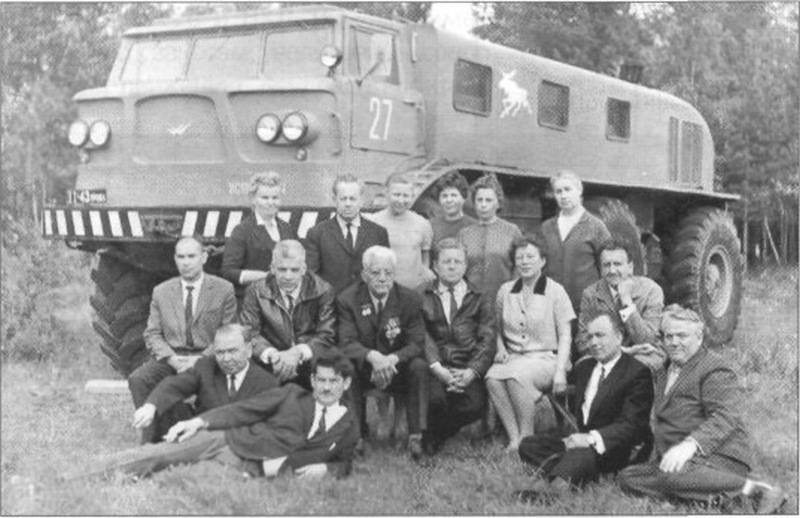
Rover and its creators. Photo Kolesa.ru
As the basis for the new ZIL-E167 all-terrain vehicle, a modified frame from the ZIL-135L was used. Several additional transverse beams and kerchiefs appeared on it, which increased the rigidity of the structure. The problem of protecting the units from external influence and placing useful volumes was solved in an original way. Instead of a one-piece body, several steel sheets were placed under the frame that served as the bottom. On top of the frame was the crew cabin, behind which they installed a hull with a cargo-passenger cabin and a engine compartment.
The power plant and transmission were based on the aggregates of the existing all-terrain vehicle. In the stern of the hull of the new prototype, it was proposed to install a pair of petrol engines ZIL-375 with the power of 180 hp. As in the case of the machine ZIL-135L, each of the engine was connected to its own transmission associated with the wheels on the same side. Near the engines, in the sides and on the roof, there were large radiators, blown by atmospheric air through the side grates. The fuel system included six tanks with a total capacity of 900 l. Tanks for fuel were on the sides of the frame between the wheels: four behind the first axis and two after the second.
Two engines worked separately, transferring power to the wheels of their sides. Directly with each of the engines was connected its own torque converter, which made it possible to equalize the parameters of the two power flows. Also on each board there were separate gearboxes, sets of cardan shafts and final drives. The twin-engine power plant was controlled by a double set of controls.
The transfer box was combined with the power take-off. The latter was needed to ensure the drive of the winch. The latter was borrowed from an experienced all-terrain vehicle ZIL-134. She could develop an effort up to 10 t and was a convenient means of self-pulling.
The chassis of the new prototype in a certain extent repeated the design of the already tested machines. The wheels of the central axis were rigidly fixed to the body, without the use of elastic suspension elements. The first and third axles received independent wheel suspension on the transverse levers. Torsion bars were used as elastic elements. Such a suspension had a stroke 240 mm. The steering system controlled the position of the two front and two rear wheels. For this, I had to use two hydraulic amplifiers at once. All wheels were equipped with drum brakes. Their work was controlled by a hydraulic system, supplemented by pneumatic amplifiers.
Especially for the ZIL-E167 prototype, new wheels have been developed. Engineers SKB ZIL, together with scientists MVTU them. Bauman created a new design of the wheel, using metal and fiberglass parts. From steel it was proposed to perform only the spacer ring and the disk for attachment to the hub. All other parts were made of fiberglass, and the wheel rim had a detachable design. The use of a new wheel design has led to significant weight savings. The new wheel was about 2,5 times lighter than that of steel. The undercarriage was completed with a centralized tire pressure adjustment system that allowed the wheel profile to be changed in accordance with the parameters of the bearing surface.
The tire used for the new wheel was a tire borrowed from the MAZ-529E tractor. Such a product had a diameter of 1790 mm and a dimension of 21.00-28. The design of the wheels also allowed the use of tires with a diameter of 1594 mm (18.00-24) or arched tires with a diameter of 1500 mm and a width of 840 mm. Depending on the type of tire and the pressure in it, it was possible to obtain specific ground pressure up to 0,6 kg / sq. Cm - the same characteristics had tracked vehicles.
Above the wheels, at the level of the bottom of the hull, there were developed wings. Under the driver's cabin, they had a rounded shape and went down. On this part of the wings there were small steps that facilitated landing in the cabin. Throughout the rest of its length, the wings were straight. In the stern of the starboard side in the wing there was a small gap necessary for the use of the door.
In front of the frame placed the cockpit with four seats and all the necessary controls. The cabin, made of fiberglass panels, unchanged borrowed from the all-terrain vehicle ZIL-135L. Behind the cockpit was an extra hull that could be used to transport people and cargo. It was also made of fiberglass. For most of the length of such a body had a rectangular cross-section with rounded corners. Above the third axis, the cab body went into the engine compartment cover. This part of the body differed gently lowering curved roof.
In the driver's cabin could accommodate four people. Observation of the road (or off-road) was carried out through large glazing. For landing in the sides there were two doors. Utility cabin had 14 seats placed along the sides. She received three rectangular windows in the sides. There was also a landing door at the rear of the starboard, which contained another window. The cockpit and passengers were connected by an opening with an additional door. In connection with the operation of equipment in difficult conditions, the cabins were equipped with heating systems. The crew cabin retained a regular heater, and autonomous heaters appeared in the cargo and passenger cabin.
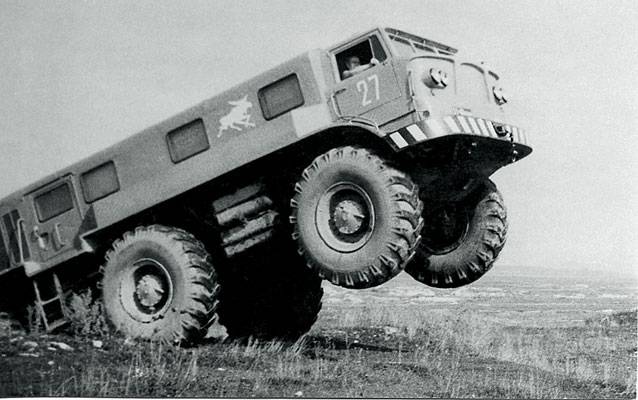
Climb to the wall. Photo Denisovets.ru
Finishing the assembly work, the staff of the Plant. Likhachev covered a mock-up sample with bright red paint. Between the first and second pair of windows on the sides of the cargo-and-passenger cabin, the emblem of the SKB ZIL appeared - a running white elk. According to the legend, such an emblem indicated the highest “permeability” of an animal capable of overcoming virgin snow of great thickness. From a certain time on the door of the driver's cab flaunted white board number "27".
The experimental all-terrain vehicle of the new type was not distinguished by its small size. Its length reached 9,26 m, width - 3,13 m, height - a little more than 3 m. When using wheels with a diameter of 1,79 m, the clearance was 852 mm. The wheelbase is 6,3 m with 3,15 m center distance. The track is 2,5 m. The curb weight ZIL-E167 was determined in 12 tons. It could take on a payload of 5 tons, after which the total weight reached 17 tons. Due to two powerful engines and efficient transmissions, the car could show high performance. Cross-country chassis provides high throughput.
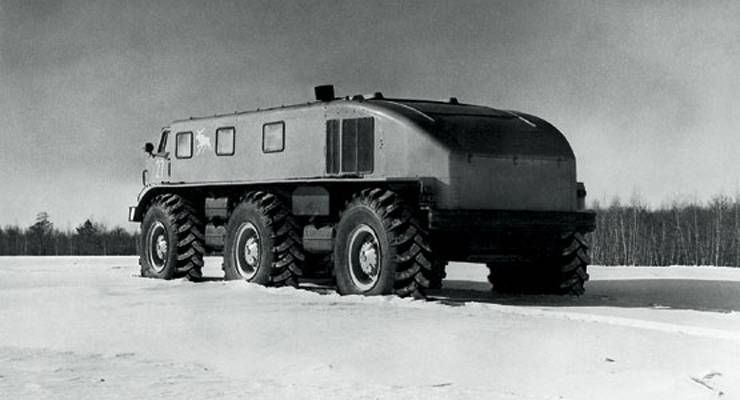
Rover on snowy terrain. Photo Denisovets.ru
The assembly of an experienced ultra-high-performance automobile ZIL-E167 ended on the last day of December 1962. Just a few days the car went to the factory tests. The first checks were carried out on the highways of the Moscow Region and ended with the end of January of the 1963. It was found that the gratings in the case do not cope with the task of supplying air to the radiators. To improve engine cooling on the sides and roof had to install additional bucket-type air intakes.
With all this, the all-terrain vehicle showed good performance. On the highway, he reached speeds of up to 75 km / h. Power reserve was 9020 km. Fuel consumption - up to 100 liters per 100 km. Passability of the unique chassis completely and completely covered requirements of any highways.
In February of the same year, an experienced ZIL-E167 set off from Moscow to the Perm Region. On the way to the destination, the car repeatedly left the track and drove off-road. On the snow-covered road, the running characteristics remained the highest and did not differ from the parameters in normal conditions. On the virgin snow, the all-terrain vehicle confidently accelerated to 8-10 km / h. There was the possibility of climbing the slope of the 42 °. The car overcame the fords to a depth of 1,8 m. For several months, the testers remained in the Perm area and studied the operation of the mechanisms in difficult conditions.
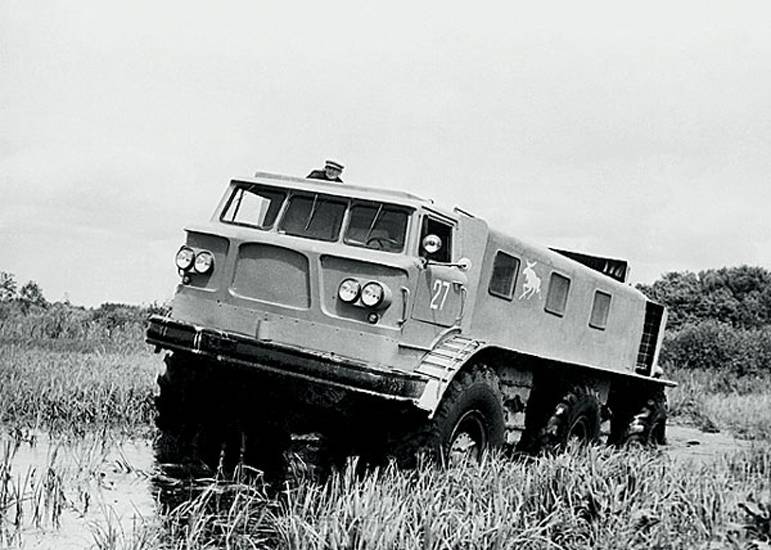
Movement through the swamp. Photo Denisovets.ru
After checking on the improvised landfills of the Perm Region, the experienced all-terrain vehicle returned to Moscow. In the summer of 1964, he again came to the test, this time in conditions close to the desert. Moscow area allowed to check the car on the sands, in the swamps and on the hills. Despite all the difficulties, the car justified its belonging to the class of ultra-high maneuverability and showed high characteristics of maneuverability. Apparently, the summer tests of the 1964 of the year made it possible to re-work the car before the next tests.
In the coming winter, a prototype model began to be attracted to work in the interests of the national economy. Autumn 1964, the plant them. Likhachev launched a full-scale mass production of the newest trucks ZIL-130, and for the production of such products he needed a certain technological equipment. Necessary products made Serdobsky engineering plant (Serdobsk, Penza region). Experienced ZIL-E167 under its own power reached Serdobsk, took several tons of equipment and returned to Moscow. This time, the all-terrain vehicle was able to show its capabilities not with ballast, but with a full load.
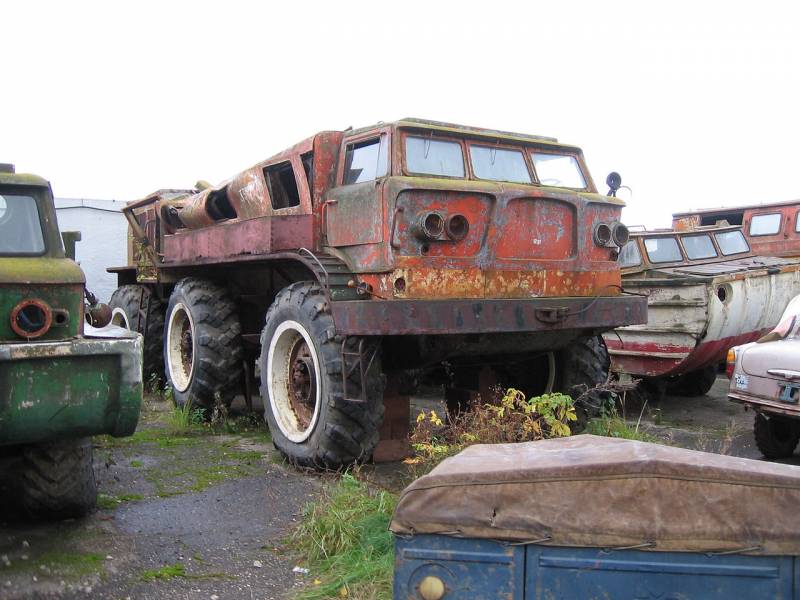
Experienced all-terrain vehicle in the middle of the two thousandth's. Storage in the open air had a bad effect on the condition of the machine. Photo of Wikimedia Commons
Soon after the cargo flight, at the beginning of the 1965 of the year, an experienced all-terrain vehicle was sent to Siberia, where the new gas pipeline Shaim-Tyumen was being built. The construction site worked in hard-to-reach taiga areas and faced with known transport problems. The ultra-high car had to make a certain contribution to the construction of a new pipeline. Transporting people and goods, ZIL-E167 without any problems overcame snow virgin depth to 1-1,1 m and freely moved along roads-winter roads. Repeatedly, the all-terrain vehicle performed the functions of a tractor, pulling away cars stuck in the snow and eliminating congestion.
Apparently, it was during this period that an amusing legend appeared, according to which an experienced Soviet all-terrain vehicle fairly scared foreign intelligence. It is said that in 1963-65, American CIA specialists, studying satellite images of Soviet territory, regularly found fresh traces of some large-scale technology in remote and inaccessible snow-covered areas, indicating its high permeability. Finally, in a short period of time, the mysterious bright red all-terrain vehicle was noticed on several photographs from different regions of the country. From this, the scouts concluded: the Russians had developed and built a whole “fleet” of powerful all-terrain vehicles. Now they can attack Canada and the United States, sending troops on such vehicles through the Arctic or even across the North Pole.
By the middle of 1965, the only prototype model of the type ZIL-E167 returned to Moscow to the factory. Now the specialists of the Special Design Bureau had to complete the analysis of the collected data and draw conclusions, including in the context of the further development of ultra-high maneuverability. According to the test results, it was suggested that an experienced all-terrain vehicle showed the maximum possible mobility and maneuverability characteristics for a wheeled vehicle.
The achievements of the ZIL-E167 project were of great interest in the context of the further development of special equipment. However, the launch of mass production of such a machine has not been planned. According to known data, a similar decision was made in 1964.
According to known data, the refusal of serial production of the ZIL-E167 all-terrain vehicle or of a car based on it had several reasons. One of the main ones is the launch of the production of the GT-T multipurpose tracked carrier. In terms of its technical characteristics, this car was inferior to the all-terrain vehicle wheel from the ZIL, but it had a number of advantages. The characteristic problem of wheeled vehicles of high and ultra-high passability was a rather complicated transmission and production. In addition, these all-terrain vehicles were very expensive.
Since a certain time, the Ministry of Defense has been interested in the ZIL-E167 project. The issue of building two new prototypes designed for new tests in the interests of the military department was considered. However, new cars of this type were not built. By the mid-sixties, the army managed to get the desired all-terrain vehicles of several models, and in such conditions, the immediate development of a new model did not make sense.
Comparison of a number of new samples of special equipment belonging to different classes led to certain conclusions. Some samples of all-terrain vehicles went into the series, while others could not get out of the test stage. The ZIL-E167 project made a great contribution to the development of all-terrain vehicles, but it did not end with an order for mass production.
After completing the tests in 1965, the only ZIL-E167 returned to Moscow at the Zaporozhevsky Plant. Likhachev, where he was kept for some time. Having stood idle for several decades, the unique car was a pitiful sight. However, a few years ago it was repaired and restored. Now it stands under a canopy in the open area of the Moscow-based Military Technical Museum (Ivanovo village).
In the mid-fifties, the Special Design Bureau of the Plant. Stalin (later them. Likhachev) began the study of the issues of creating ultra-high-cross vehicles for the armed forces and individual industries. For some time, the bureau and the plant built prototypes of prototypes, which were used to test certain bold ideas. The logical result of such works, which showed the highest characteristics, was a prototype ZIL-E167. In parallel with the testing of experimental machines, SKB ZIL created complete machines suitable for practical operation. The groundwork for the prototype ZIL-E167 was soon used in new off-road projects.
Based on:
http://denisovets.ru/
http://gvtm.ru/
http://russianarms.ru/
http://kolesa.ru/
Kochnev E.D. Secret cars of the Soviet Army. - M .: Yauza, Eksmo, 2011.
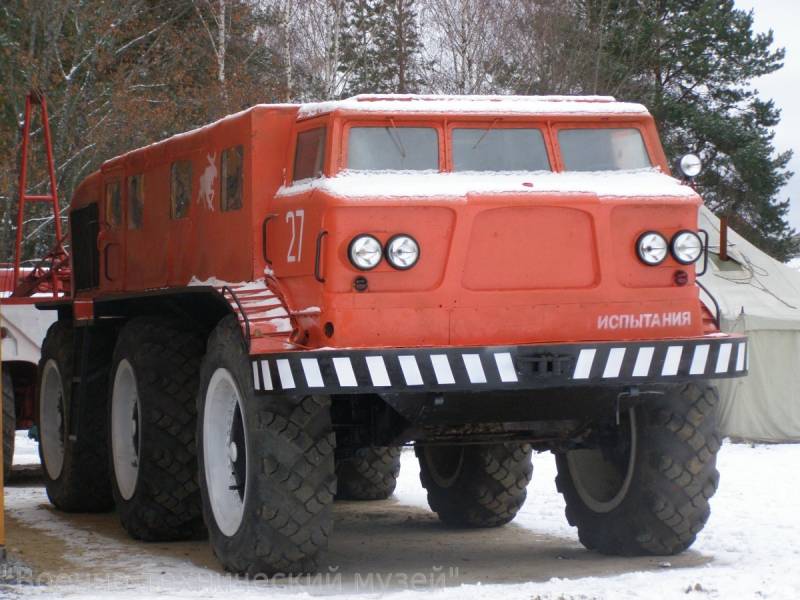
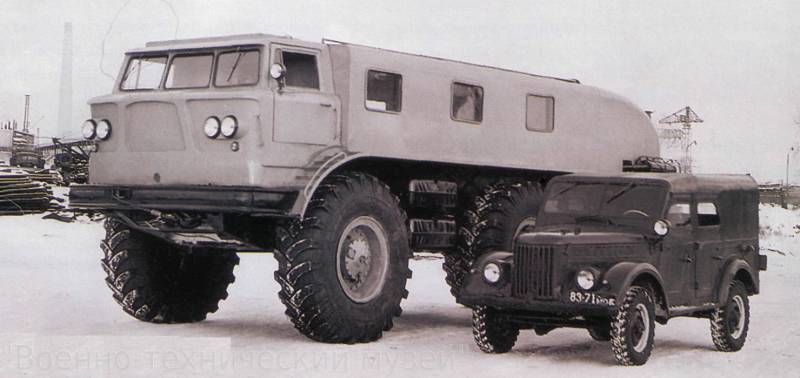
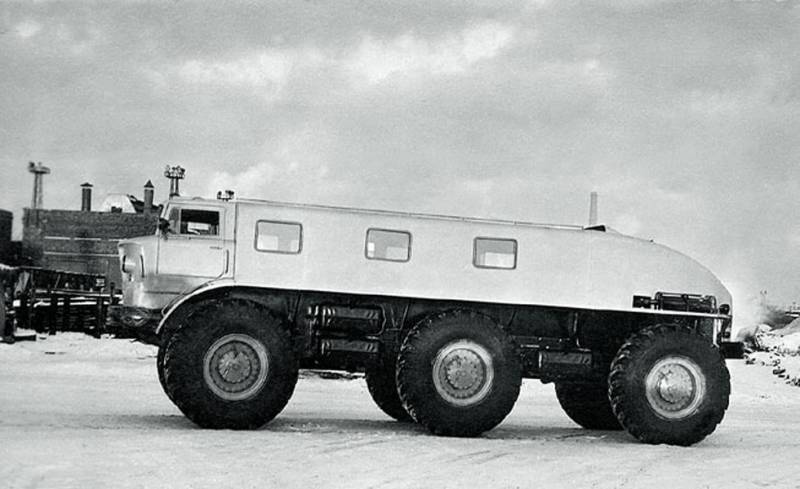
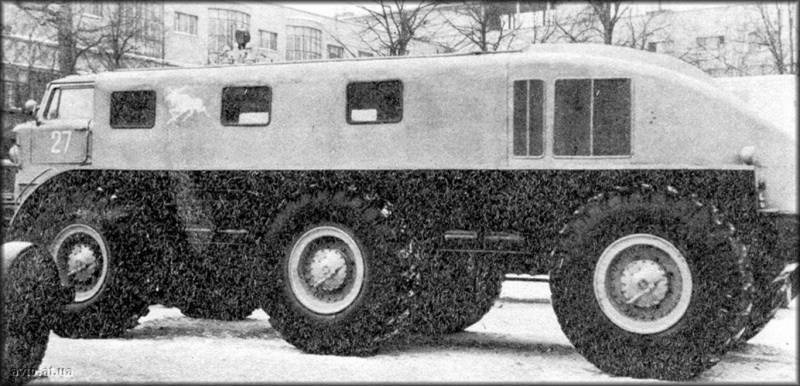
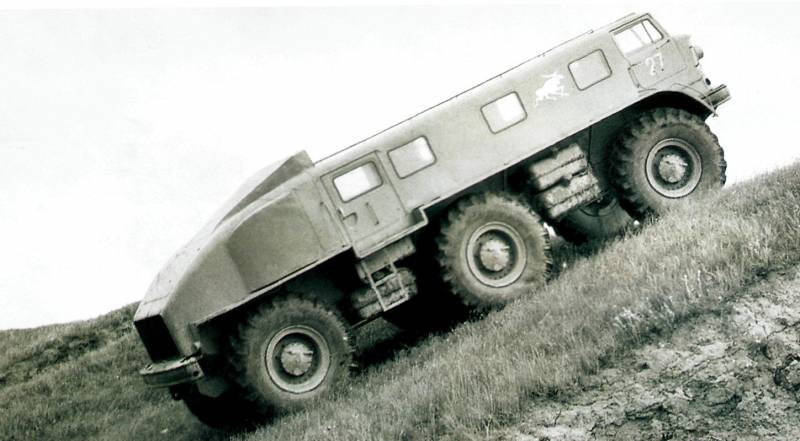
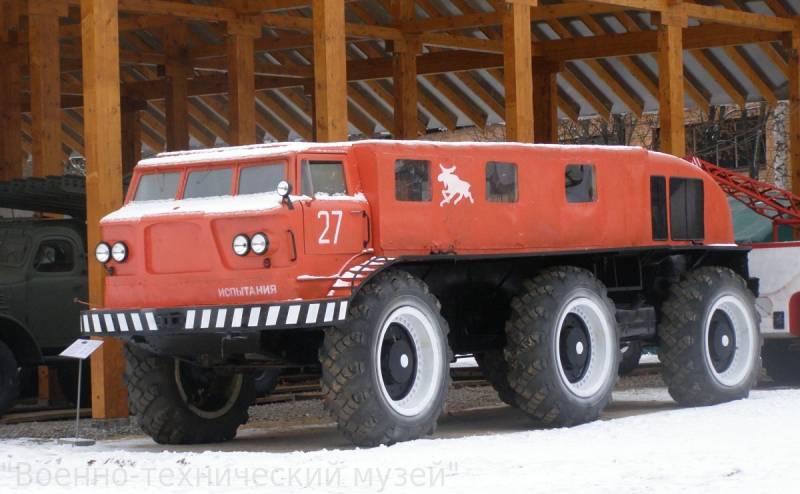
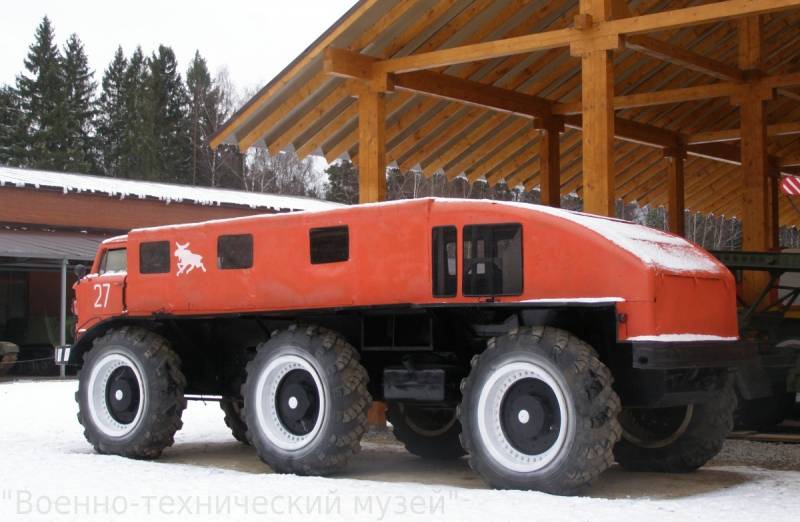
Information